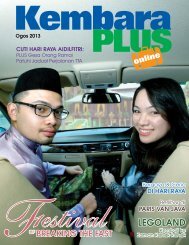Kembara PLUS - 2014 Jan Feb
You also want an ePaper? Increase the reach of your titles
YUMPU automatically turns print PDFs into web optimized ePapers that Google loves.
FEATURES<br />
The villagers took the old man’s advice and the Nian was<br />
conquered. On the anniversary of the date, the Chinese<br />
recognize the “passing of the Nian” which is also synonymous<br />
with celebrating the new year.<br />
The date of Chinese New Year changes each year as it is<br />
based on the lunar calendar. Because Japan, Korea, Mongolia,<br />
Tibet and Vietnam also celebrate the new year based on the<br />
Chinese lunisolar calendar, the preferred and politically correct<br />
greeting these days would be “Happy Lunar New Year”.<br />
<strong>2014</strong> GALLOPS IN<br />
Gong Xi Fa Cai!<br />
The new Moon on <strong>Jan</strong>uary 31 begins the year of the Wood Horse, a time of fast victories,<br />
unexpected adventure, and surprising romance. According to astrologists and feng shui experts,<br />
it is an excellent year for travel. Energy is high and production is rewarded. Decisive action, not<br />
procrastination, brings victory. But you have to act fast in a Horse year. Events move so quickly in<br />
a Horse year that you don’t want to gallop off in the wrong direction.<br />
Chinese New Year is rooted in much a celebration of<br />
spring just like Easter or Passover. The New Year was<br />
likely the start of preparations for a new growing<br />
season. However, according to legend, the Chinese<br />
New Year celebration started out of fear.<br />
On this day, families travel long distances to meet and make<br />
merry. The reunion feast on New Year’s Eveis a time of family<br />
bonding and a tradition not to be missed. Some families may<br />
invite a lion dance troupe as a symbolic ritual to usher in the<br />
Chinese New Year as well as to evict bad spirits from the<br />
premises. Members of the family who are married also give<br />
red packets containing cash known as lai see or angpow, a<br />
form of blessings and to suppress the aging and challenges<br />
associated with the coming year, to junior members of the<br />
family, mostly children and teenagers.<br />
The Chinese New Year festivities last for 15 days, ending<br />
with Chap Goh Mei. In Malaysia and Singapore, this day is<br />
celebrated by individuals seeking for a love partner, where<br />
single women would write their contact number on mandarin<br />
oranges and throw it in a river or a lake while single men would<br />
collect them and eat the oranges. The taste is an indication of<br />
their possible love: sweet represents a good fate while sour<br />
represents a bad fate.<br />
Angpow is a form of blessings<br />
Wearing red wards off evil and brings good luck<br />
It tells a story of a terrible mythical monster who<br />
preyed on villagers. The lion-like monster’s name<br />
was Nian which is also the Chinese word for “year.”<br />
A wise old man counsels the villagers to ward off<br />
the evil Nian by making loud noises with drums<br />
and firecrackers and hanging red paper cutouts and<br />
scrolls on their doors because for some reason, the<br />
Nian is scared of the color red.<br />
A parade recreating the passing of the Nian<br />
Winter boots for sale at a pedestrian mall<br />
Celebrating the lunar new year with parade, dance and food<br />
5 KEMBARA <strong>PLUS</strong> ONLINE JANUARI/FEBRUARI <strong>2014</strong> 6 KEMBARA <strong>PLUS</strong> ONLINE JANUARI/FEBRUARI <strong>2014</strong>






